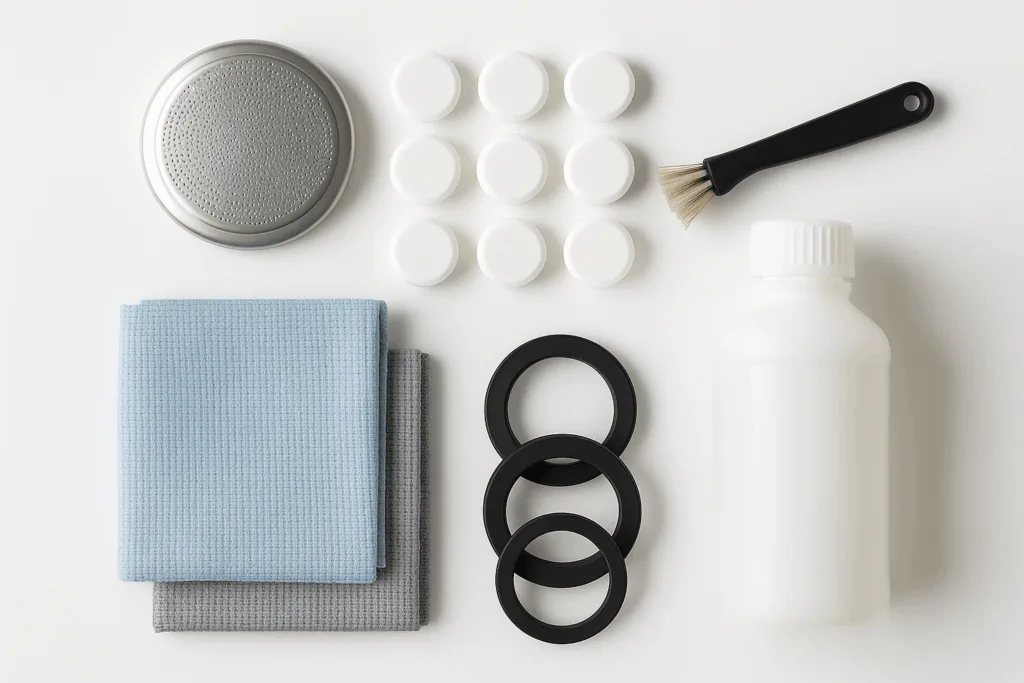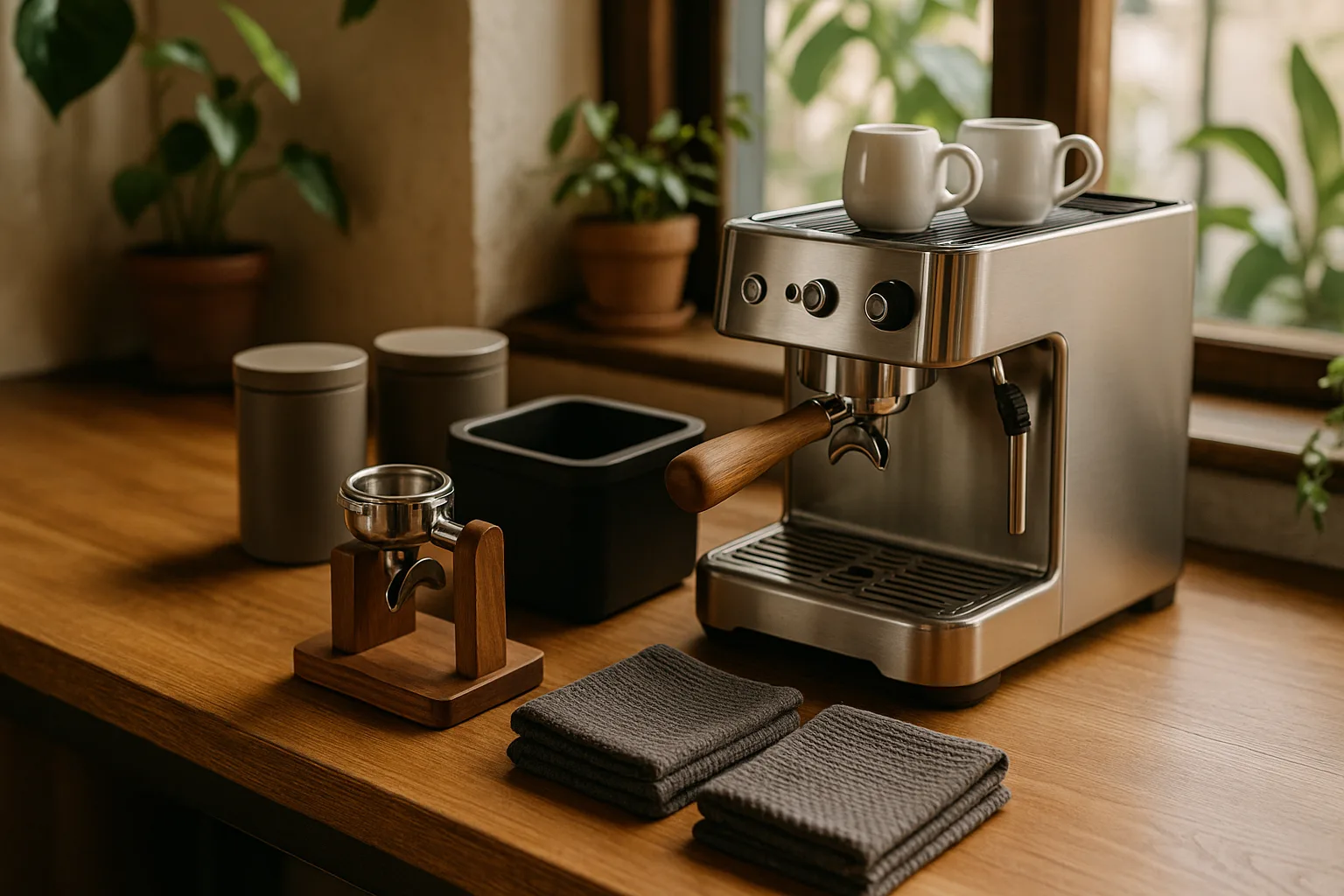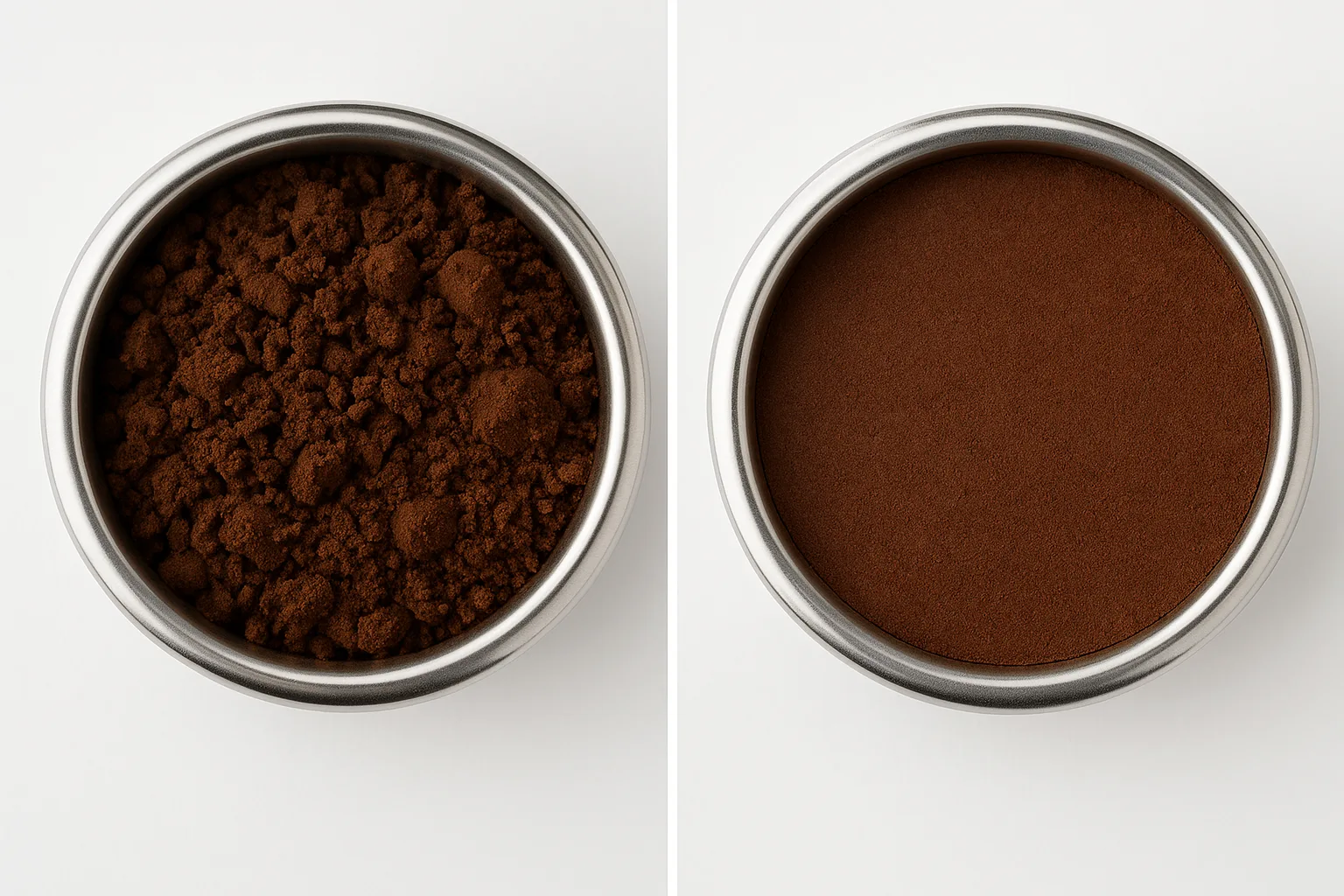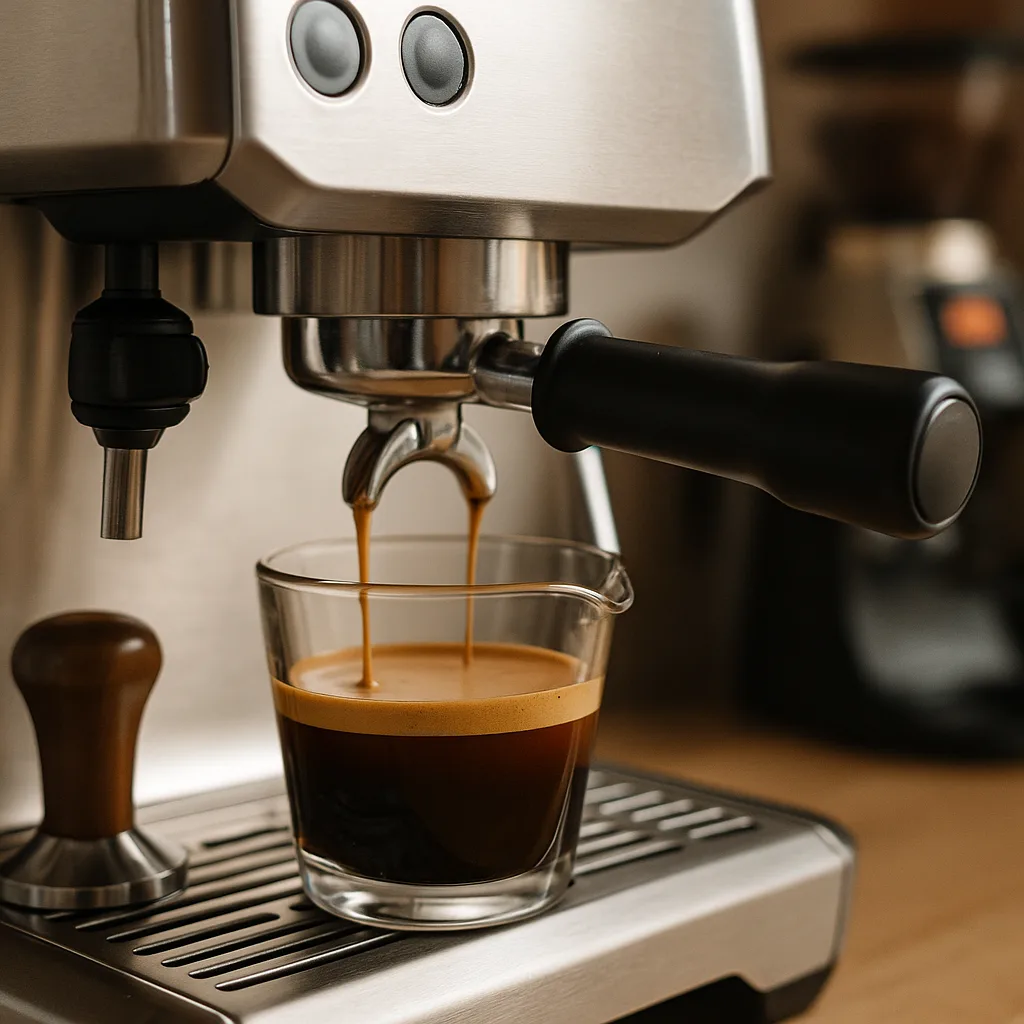Table of Contents
I’ll never forget the first time I pulled a truly café-quality shot at home. It wasn’t after buying a fancier machine—it was the day I finally invested in a proper tamper and scale. That’s when everything clicked. The truth is, your espresso machine is only part of the equation. The right espresso machine accessories can transform your home brewing from frustrating guesswork into a consistent, rewarding ritual.
Whether you’re just starting your espresso journey or you’ve been pulling shots for years, the accessories you choose make all the difference between watery, bitter disappointments and rich, balanced espresso with that gorgeous crema you’ve been chasing. In this comprehensive guide, I’m breaking down everything you need to know about espresso machine accessories—from the absolute essentials to the game-changing upgrades that’ll take your shots to the next level.
As Breville’s espresso accessory guide highlights, investing in the right tools — like a precision tamper, dosing funnel, and scale — can make the difference between a decent espresso and a perfectly extracted one.
Let’s dive into the world of espresso accessories and discover how the right tools can unlock your espresso potential.
Key Takeaways
- Essential espresso machine accessories like tampers, scales, and milk pitchers are non-negotiable for consistent, café-quality espresso at home
- Advanced tools like WDT distributors and puck screens can dramatically improve extraction and reduce channeling
- Proper maintenance accessories extend your machine’s lifespan and keep your espresso tasting fresh
- Building a well-organized espresso station improves your workflow and makes the daily ritual more enjoyable
- You don’t need everything at once—start with the essentials and upgrade as your skills develop

Why Espresso Machine Accessories Matter for Home Baristas
Here’s something most people don’t realize when they buy their first espresso machine: the machine itself is just the beginning. I’ve seen countless home baristas struggle with inconsistent shots, blaming their equipment, when the real issue was missing the fundamental tools that make precision possible.
The Gap Between Potential and Performance
Your espresso machine—whether it’s a $300 entry-level model or a $2,000 dual boiler—has incredible potential. But without the right accessories, you’re essentially trying to paint a masterpiece with a broken brush. The accessories bridge the gap between what your machine can do and what you’re actually getting in your cup.
Think about it this way: professional baristas don’t just have better machines. They have calibrated tools, precise measurements, and consistent techniques. The good news? You can replicate that at home with the right espresso accessories.
What Accessories Actually Do for Your Coffee
Let me break down the real-world impact:
Consistency 🎯
Accessories like scales and distribution tools ensure you’re using the same dose, pressure, and technique every single time. No more guessing games.
Extraction Quality ☕
Tools like WDT (Weiss Distribution Technique) needles and precision baskets help you achieve even extraction, eliminating those sour or bitter notes that come from channeling.
Workflow Efficiency ⚡
The right setup—with knock boxes, dosing funnels, and organized storage—makes your morning routine smooth instead of chaotic.
Machine Longevity 🛠️
Cleaning accessories and maintenance tools protect your investment, preventing scale buildup and ensuring your machine performs like new for years.
The Cost-to-Impact Ratio
One of my favorite things about espresso accessories is their incredible value. A $30 scale or a $25 tamper can have a bigger impact on your shot quality than upgrading from a $500 machine to a $1,000 one. I always tell beginners: invest in accessories before you invest in a fancier machine.
When you’re ready to explore more options, check out our comprehensive product guides to find exactly what fits your setup and budget.
Essential Espresso Machine Accessories You Actually Need

Let’s cut through the noise. When you’re just starting out (or even if you’ve been brewing for a while), these are the non-negotiable espresso accessories that’ll make the biggest difference in your daily shots.
1. Precision Coffee Scale ⚖️
This is hands-down the most important accessory you’ll ever buy. I’m not exaggerating when I say a good scale transformed my espresso game overnight.
Why you need it:
- Measures your coffee dose to 0.1g accuracy
- Times your shot for consistent extraction
- Eliminates the guesswork that leads to sour or bitter shots
What to look for:
- Built-in timer function
- Water-resistant design
- Fast response time (important when timing shots)
- Capacity of at least 2kg
Without a scale, you’re just hoping for the best. With one, you’re dialing in with precision. I recommend keeping a simple log of your doses and times until you find your sweet spot—usually around 18g in, 36g out, in 25-30 seconds.
2. Quality Tamper 🎯
Your machine might come with a plastic tamper, but trust me—it’s worth upgrading immediately. A proper tamper creates an even puck that allows water to flow uniformly through your coffee grounds.
What makes a good tamper:
- Fits your portafilter basket precisely (usually 51mm, 53mm, or 58mm)
- Comfortable, weighted handle
- Flat or slightly convex base
- Stainless steel construction
Pro tip: The perfect tamp isn’t about brute force. It’s about creating a level, evenly compressed puck. Apply about 30 pounds of pressure (it’s less than you think) and focus on keeping it perfectly horizontal.
3. Milk Frothing Pitcher 🥛
If you enjoy lattes, cappuccinos, or flat whites, a proper milk pitcher is essential. The cheap one that came with your machine? It’s probably not doing you any favors.
Key features:
- Stainless steel construction (holds temperature better)
- Pointed spout for latte art
- 12oz or 20oz capacity (depending on your typical drink size)
- Easy-to-read measurement markings inside
The shape of your pitcher actually affects how milk circulates during steaming. A good pitcher creates that perfect whirlpool that transforms milk into silky microfoam instead of bubbly froth.
4. Knock Box 🗑️
This seems like a luxury until you’ve spent a week banging spent pucks into your trash can and making a mess everywhere. A knock box is simple but game-changing for your workflow.
Why it matters:
- Keeps your workspace clean
- Protects your portafilter from damage
- Speeds up your routine between shots
- Rubber or silicone bar absorbs impact
I keep mine right next to my machine. After pulling a shot, one quick knock and I’m ready to dose the next round. It’s one of those espresso machine accessories that seems minor until you have it—then you can’t imagine life without it.
5. Cleaning Brush and Backflush Detergent 🧹
Your espresso machine needs regular cleaning to perform its best and last for years. Backflushing removes coffee oils and residue from your group head and keeps everything tasting fresh.
Essential cleaning tools:
- Group head cleaning brush
- Backflush detergent (like Cafiza)
- Blind basket or rubber backflush insert
- Microfiber cloths
I backflush my machine once a week and do a deep clean monthly. The difference in taste is noticeable—old coffee oils turn rancid and make even the best beans taste off.
Want to dive deeper into maintenance? Our FAQ section covers common cleaning questions and troubleshooting tips.
Quick Comparison: Essential Espresso Machine Accessories
Here’s a helpful overview of the must-have accessories to get you started:
| Accessory | Description | Key Feature | Best For | Price Range | Action |
|---|---|---|---|---|---|
Coffee Scale with Timer |
Precision scale for measuring dose and timing shots | 0.1g accuracy, built-in timer, water-resistant | All Levels | $$ |
View Product |
Calibrated Tamper |
Professional tamper for even puck compression | Stainless steel, ergonomic handle, precise fit | Beginners+ | $$$ |
View Product |
Milk Frothing Pitcher |
Stainless steel pitcher for steaming milk | Pointed spout, measurement marks, 12–20oz options | Milk Drinks | $ |
View Product |
Knock Box |
Container for disposing of used espresso pucks | Durable bar, easy to clean, compact design | All Levels | $$ |
View Product |
Cleaning Kit |
Complete set for backflushing and maintenance | Brushes, detergent, blind basket, cloths | Essential | $ |
View Product |
Advanced Tools That Take Your Espresso to the Next Level
Once you’ve mastered the essentials, these advanced espresso machine accessories will help you achieve even better extraction and unlock flavors you didn’t know were possible. I resisted buying some of these for months, thinking they were overkill—but each one made a noticeable difference.
WDT (Weiss Distribution Technique) Tool 🔄
This is probably the single biggest upgrade I’ve made to my espresso routine. A WDT tool uses ultra-thin needles to break up clumps and distribute grounds evenly in your portafilter basket.
Why it’s a game-changer:
- Eliminates channeling (when water finds the path of least resistance)
- Creates more uniform extraction
- Reduces those frustrating sour or bitter notes
- Works with any grinder, especially helpful with single-dose grinders
How to use it:
After dosing your coffee into the portafilter, use the WDT tool to gently stir in a circular pattern, reaching all the way to the bottom of the basket. You’ll see clumps break apart and the grounds settle more evenly. Then tamp as usual.
I was skeptical until I tried it. The difference in clarity and sweetness was immediate. It’s especially helpful if you’re using lighter roasts where channeling becomes more obvious.
Puck Screen 🛡️
This is a newer accessory that’s gained serious popularity in the home barista community, and for good reason. A puck screen is a precision-cut metal screen that sits on top of your coffee puck before brewing.
Benefits:
- Prevents the shower screen from getting clogged with coffee particles
- Promotes more even water distribution across the puck
- Keeps your group head cleaner
- Can improve shot consistency
Worth noting:
You’ll need to adjust your dose slightly (usually 0.5-1g less) to account for the screen’s thickness. And make sure to get the right diameter for your basket—usually 58mm for most home machines.
Bottomless (Naked) Portafilter 👁️
This might seem like just a cool visual upgrade, but a bottomless portafilter is actually an incredible diagnostic tool. Without the spouts, you can see exactly what’s happening during extraction.
What you’ll learn:
- Whether your puck prep is even (channeling shows up immediately)
- If your grind size needs adjustment
- Whether your tamp is level
- The quality of your extraction in real-time
The catch:
It’s unforgiving. Every mistake becomes visible—which is exactly why it’s such a valuable learning tool. Plus, once you nail your technique, watching those beautiful streams of espresso merge into one is incredibly satisfying.
Precision Filter Baskets 🎯
Your machine probably came with standard baskets, but upgrading to precision baskets (like IMS or VST) can genuinely improve extraction.
What makes them different:
- More uniform hole size and distribution
- Higher hole count for better water flow
- Straighter walls for more consistent puck geometry
- Better quality control in manufacturing
The result? More even extraction and better-tasting espresso. It’s a subtle upgrade, but when you’re chasing that last 5% of improvement, it matters.
Dosing Funnel (Portafilter Collar) 📐
This simple aluminum or 3D-printed ring sits on top of your portafilter and prevents coffee grounds from spilling everywhere during dosing and WDT.
Why you need it:
- Keeps your counter clean
- Allows you to dose more confidently
- Makes WDT tool use mess-free
- Magnetic versions attach securely to your portafilter
It’s one of those espresso machine accessories that costs $15-20 and you’ll use every single day. The time saved on cleanup alone makes it worth it.
For more detailed comparisons of these advanced tools, visit our product comparison page where you can see specs side-by-side.
Aesthetic and Functional Add-Ons to Elevate Your Setup

Let’s be honest—part of the joy of being a home barista is creating a beautiful espresso station that makes you excited to brew every morning. These espresso machine accessories combine form and function to elevate both your coffee and your space.
Espresso Cups and Demitasse Sets ☕
The right cup isn’t just about aesthetics (though that matters too). Cup material, thickness, and shape actually affect how your espresso tastes and cools.
What to look for:
- Thick ceramic walls that retain heat
- 2-3 oz capacity for traditional espresso
- Tapered shape that concentrates aromas
- Pre-warmed before use (I keep mine on top of my machine)
I love double-walled glass cups for their visual appeal—watching the crema settle is part of the experience. But for pure heat retention, nothing beats a classic thick-walled ceramic demitasse.
Pro tip: Warm your cups with hot water before pulling your shot. A cold cup drops the temperature of your espresso immediately, muting flavors.
Coffee Storage Canisters 🫙
Fresh beans are the foundation of great espresso, and proper storage is essential. Once you open a bag of coffee, it starts losing freshness due to oxygen exposure.
Storage essentials:
- Airtight seal (one-way valves are ideal)
- Opaque material to block light
- Size appropriate for your consumption (don’t store more than 2 weeks’ worth)
- Date labeling system to track freshness
I use vacuum-sealed canisters with CO2 valves. They’re not cheap, but they keep my beans noticeably fresher. The difference between week-old beans stored properly versus poorly is dramatic.
Barista Towels and Microfiber Cloths 🧽
This seems mundane, but having dedicated cleaning cloths makes a huge difference in your workflow and machine maintenance.
What I keep at my station:
- Microfiber cloths for wiping the steam wand (immediately after each use)
- Absorbent bar towels for cleaning the portafilter and workspace
- Dedicated group head brush (never use the same cloth for multiple surfaces)
I go through 2-3 towels per session, and I wash them weekly with unscented detergent. Coffee oils build up fast, and you don’t want old rancid oils transferring to your equipment.
Portafilter Stand 🏗️
A simple stand keeps your portafilter organized, clean, and ready to use. It’s especially helpful if you have multiple portafilters (like a standard and bottomless).
Benefits:
- Keeps portafilters off the counter (more hygienic)
- Allows them to dry properly between uses
- Organizes your workspace
- Prevents damage to baskets
Some stands even include spots for your tamper, WDT tool, and other small espresso machine accessories—keeping everything within arm’s reach.
Espresso Spoons and Stirrers 🥄
For those who add sugar or simply want to stir their espresso before drinking, proper demitasse spoons complete the experience.
Aesthetic touches:
- Stainless steel or copper finish
- Proportioned for small cups
- Comfortable weight and balance
These are small details, but they’re part of what makes the home espresso ritual feel special rather than rushed.
Maintenance and Cleaning Accessories for Long-Term Performance
Your espresso machine is an investment—sometimes a significant one. These maintenance accessories protect that investment and ensure every shot tastes as good as the first.
Backflushing Supplies 🔄
Regular backflushing removes coffee oils and residue from your machine’s internal components. If you have an E61 group head or any machine with a 3-way solenoid valve, backflushing is essential.
What you need:
- Blind basket (or rubber backflush insert for your regular basket)
- Espresso machine cleaner (Cafiza, Puly Caff, or similar)
- Group head cleaning brush with angled bristles
How often:
I backflush with just water after every session and with detergent once a week. The process takes 2 minutes and makes a massive difference in taste.
The process:
- Insert blind basket with a small amount of cleaner
- Run the brew cycle for 10 seconds
- Let it sit for 10 seconds
- Repeat 5-6 times
- Run several cycles with just water to rinse
The first time you backflush properly, you’ll be shocked by what comes out. That’s all the stuff that would otherwise end up in your coffee.
Descaling Solutions 🧪
Scale buildup from minerals in water is the silent killer of espresso machines. Even if you use filtered water, descaling should be part of your regular maintenance routine.
Descaling essentials:
- Commercial descaler (Dezcal, manufacturer-specific solution)
- Or citric acid (natural, effective alternative)
- Never use vinegar (it can damage internal components)
Frequency:
This depends on your water hardness. I descale every 2-3 months with moderately hard water. If you have very hard water, monthly descaling might be necessary.
Signs you need to descale:
- Longer heat-up times
- Reduced water flow or pressure
- Temperature inconsistencies
- Strange tastes in your espresso
Water Filtration Systems 💧
Speaking of water quality—it’s arguably the most overlooked aspect of espresso. Water makes up 98% of your drink, and the minerals in it affect both taste and machine health.
Water solutions:
- Simple pitcher filters (Brita, PUR) – basic filtration
- In-line water filters – attach directly to your machine
- Third-wave water packets – remineralize distilled water to ideal specs
- RO systems – complete control (requires remineralization)
I use filtered water with a balanced mineral content. Too soft (like distilled) and your espresso tastes flat. Too hard and you get scale buildup and metallic flavors.
Grinder Cleaning Tools 🌪️
Don’t forget about your grinder—it needs maintenance too. Coffee oils build up on burrs and in the grind chamber, eventually going rancid.
Grinder maintenance:
- Grinder cleaning tablets (Grindz, Urnex) – absorb oils and clean burrs
- Small brushes for removing grounds from the chamber
- Vacuum for deep cleaning (I use a small handheld)
I run cleaning tablets through my grinder monthly and do a full disassembly and deep clean every 3-4 months. The improvement in taste is noticeable—old oils make everything taste bitter and stale.
Replacement Gaskets and Seals 🔧
Over time, rubber gaskets and seals wear out. Having spares on hand means you’re not waiting for shipping when something fails.
Keep these on hand:
- Group head gasket (replace yearly or when you notice leaking)
- Portafilter basket seals
- Steam wand O-rings
- Manufacturer-specific parts for your machine
When your group head gasket starts to fail, you’ll notice water leaking around the portafilter during extraction. Replacing it is usually a 10-minute job and costs under $10.
For more detailed maintenance guides and troubleshooting, check out our FAQ page where we cover common issues and solutions.
Building the Perfect Espresso Station at Home

Creating an efficient, beautiful espresso station isn’t just about aesthetics—it’s about workflow, ergonomics, and making your daily ritual something you look forward to. Here’s how to set up a space that works.
Location and Space Planning 📐
Ideal setup requirements:
- Counter space: Minimum 24″ wide, ideally 30-36″
- Electrical: Dedicated 15-amp circuit (some dual boilers need 20-amp)
- Clearance: 18″ above machine for refilling water tank
- Proximity to sink: Makes filling, cleaning, and dumping easier
I learned this the hard way—my first setup was in a corner with barely enough room to move. I was constantly bumping into things and spilling grounds. When I redesigned with proper clearance, my whole workflow improved.
The Workflow Triangle ▶️
Just like in kitchen design, your espresso station should follow a logical flow:
- Grinder (left or right, depending on your dominant hand)
- Espresso machine (center position)
- Knock box and cleaning station (opposite side from grinder)
This creates a natural left-to-right or right-to-left workflow: grind → dose → tamp → brew → knock out puck → clean.
Storage zones:
- Beans near the grinder
- Cups near the machine (on top for pre-warming)
- Accessories (tamper, WDT, funnel) within arm’s reach
- Cleaning supplies underneath or nearby
Essential Station Components 🏗️
Surface protection:
- Espresso mat or tray to catch drips and protect countertops
- Heat-resistant material under machine
- Easy to clean surface (I use a silicone mat)
Organization:
- Portafilter stand to keep things tidy
- Accessory holder for tamper, WDT tool, and brushes
- Cup storage that keeps cups warm and accessible
- Drawer or cabinet for backup supplies
Lighting:
- Under-cabinet lighting helps you see puck prep clearly
- Natural light is ideal but not always possible
- Adjustable task lighting for precision work
Personalization and Style ✨
Your espresso station should reflect your personality and make you happy. Here’s where aesthetics meet function:
Color coordination:
- Match accessories to your machine’s finish (stainless, black, copper)
- Coordinate towels, mats, and storage containers
- Create visual cohesion without sacrificing function
Decorative elements:
- Vintage espresso posters or coffee-themed art
- A small plant (adds life without taking up much space)
- Display your favorite beans in glass jars
- Quality cutting board or wooden tray as a base
Functional décor:
- Beautiful espresso cups on display
- Aesthetic storage canisters that keep beans fresh
- Copper or brass accessories that patina over time
- A small chalkboard for tracking recipes and doses
Multi-Machine Setups 🔄
If you’re deep into the hobby, you might have multiple grinders or machines for different purposes:
Common multi-setup scenarios:
- Espresso grinder + Pour-over grinder (different grind ranges)
- Manual lever + Semi-automatic (for different experiences)
- Dedicated milk setup (separate pitcher, thermometer, practice area)
The key is organizing so each tool has its place and purpose. I’ve seen beautiful setups where everything has a home, and chaotic ones where $5,000 worth of equipment is crammed into a cluttered corner.
Cable Management 🔌
Nothing ruins a beautiful setup like tangled cables everywhere.
Solutions:
- Cable clips attached to the underside of cabinets
- Cable sleeves to bundle multiple cords
- Power strip mounted out of sight
- Velcro ties for excess cable length
I mounted a power strip with surge protection under my counter and used cable clips to route everything neatly. It takes 30 minutes to set up but makes a huge visual difference.
Maintenance Station 🧰
Dedicate a small area or drawer to cleaning and maintenance supplies:
What to keep accessible:
- Backflush detergent and blind basket
- Descaling solution
- Microfiber cloths and bar towels
- Brushes and cleaning tools
- Replacement parts (gaskets, seals)
Having everything in one place means you’re more likely to maintain your equipment regularly. Out of sight, out of mind—so keep it visible and organized.
Want more inspiration for your setup? Browse our product categories to discover espresso machine accessories that fit your style and workflow. According to Perfect Daily Grind, espresso gadgets are no longer niche items — they’re becoming standard tools even in professional coffee competitions, reflecting how home baristas are driving innovation in coffee gear.
Conclusion: Elevate Your Espresso Experience
Here’s what I’ve learned after years of pulling shots at home: your espresso machine is only as good as the espresso machine accessories you pair with it. The difference between frustrating, inconsistent espresso and café-quality shots you’re proud of often comes down to a $30 scale, a proper tamper, and the right technique.
You don’t need everything at once. Start with the essentials—scale, tamper, milk pitcher, knock box, and cleaning supplies. Master those tools and develop your technique. Then, as you grow more confident, add advanced accessories like WDT distributors, puck screens, and precision baskets that’ll help you chase even better extraction.
Remember, espresso is a journey, not a destination. Every shot teaches you something. Every accessory you add should serve a purpose—either improving your coffee, streamlining your workflow, or bringing you more joy in the daily ritual.
Your Next Steps ☕
Ready to upgrade your espresso setup? Here’s what I recommend:
- Assess your current setup – What’s missing? What’s frustrating you?
- Start with one essential – Usually a scale if you don’t have one
- Master that tool before adding the next
- Join the community – Share your setup, ask questions, learn from others
At Espresso Insider, we’re here to help you brew with confidence. Whether you’re comparing machines, choosing beans, or building your perfect espresso station, we’ve got clear, trusted guidance to support your journey.
Explore our product reviews and comparisons, check out our detailed guides, or reach out through our About Us page if you have questions.
Your best espresso is waiting. All you need are the right tools and the confidence to use them. Now go pull some incredible shots. ☕✨
FAQ: Espresso Machine Accessories

What espresso machine accessories do I actually need as a beginner?
Start with the essential five: a precision scale with timer, quality tamper (matching your portafilter size), milk frothing pitcher (if you make milk drinks), knock box, and basic cleaning supplies.
These accessories will have the biggest impact on your shot quality and consistency. You can add advanced tools like WDT distributors and puck screens later as your technique develops.
How much should I spend on espresso accessories?
Budget $100-200 for essentials when starting out. A good scale ($30-60), quality tamper ($25-40), frothing pitcher ($15-25), knock box ($20-30), and cleaning kit ($15-25) will cover your core needs.
As you advance, you can invest in premium accessories, but start with solid basics rather than cheap versions you’ll need to replace.
Do expensive espresso machine accessories make better coffee?
Quality matters more than price. A $30 calibrated tamper will outperform a $100 decorative one that doesn’t fit properly. That said, precision tools (like IMS baskets or quality scales) do make measurable differences.
Focus on function over aesthetics initially—you can upgrade to beautiful, high-end accessories once you’ve mastered the fundamentals.
How often should I clean my espresso machine accessories?
Daily: Wipe steam wand after each use, rinse portafilter and baskets, empty knock box.
Weekly: Backflush with detergent, deep clean baskets and shower screen, wash all towels.
Monthly: Grinder cleaning tablets, descale machine (if needed), inspect gaskets.
Quarterly: Full machine teardown and deep clean. Consistent maintenance prevents problems and keeps your espresso tasting fresh.
What’s the difference between a regular tamper and a calibrated tamper?
A calibrated tamper has a spring mechanism that clicks when you’ve applied the correct pressure (usually 30 pounds). This ensures consistency between shots and prevents over-tamping.
Regular tampers rely on your feel and technique. For beginners, calibrated tampers remove one variable from the equation. For experienced baristas, a quality regular tamper with good technique works just as well.
Can I use regular cleaning products on my espresso machine?
No—never use household cleaners. Espresso machines require food-safe, coffee-specific cleaning products like Cafiza or Puly Caff. These are formulated to break down coffee oils without leaving harmful residues.
Avoid vinegar for descaling (it can damage internal components)—use proper descaling solutions instead. The wrong cleaners can damage your machine and contaminate your coffee.
What size portafilter espresso machine accessories do I need?
Check your portafilter basket diameter—most home machines use 58mm, 54mm, or 51mm. Your tamper must match this size precisely (within 0.5mm) for proper compression.
Puck screens, dosing funnels, and precision baskets also need to match. Measure your basket or check your machine’s specifications before ordering espresso machine accessories.
Are bottomless portafilters worth it for home use?
Absolutely. Bottomless (naked) portafilters are incredible diagnostic tools that reveal channeling, uneven tamping, and grind distribution issues instantly. They’re unforgiving—every mistake shows—which makes them perfect for improving technique.
Plus, they’re easier to clean and allow you to use larger cups. Just expect a learning curve and some messy counters at first.





Leave a Reply
You must be logged in to post a comment.